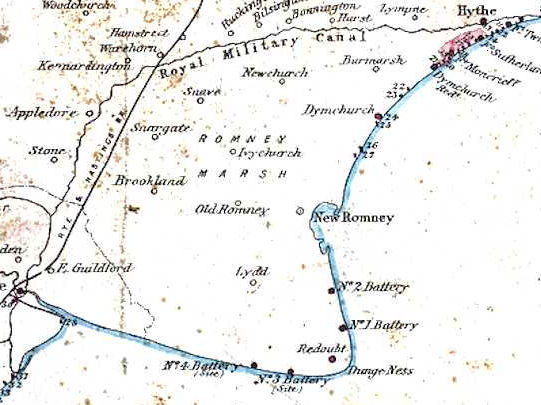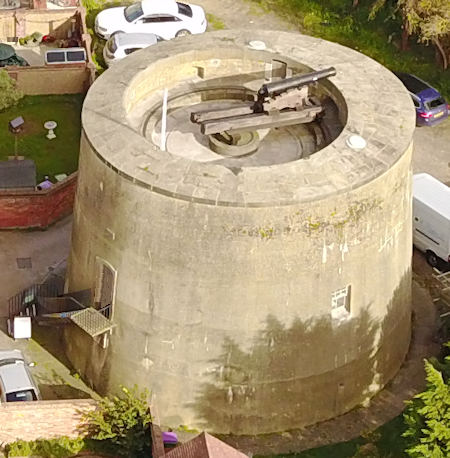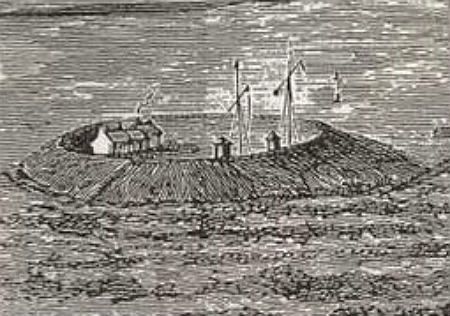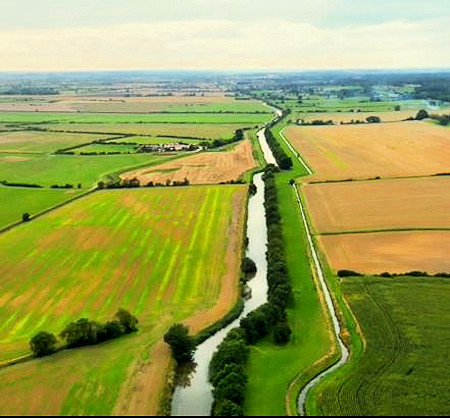Military Heritage on Romney Marsh
Romney Marsh, and particularly its coastline, has a wealth of Military Heritage extending over many centuries. The Marsh has always been 
vulnerable to invasion, given its close proximity to the European Continent - France is just 29 miles away across the English Channel - and its
flat shores and hinterland with easily accessible beaches.
Invaders from the Romans legions, the Anglo-Saxons, the Vikings, the French, and the Germans have all tried. So it is no surprise that this iconic stretch of the Kent coastline, known as the Invasion Coast, has many Military Heritage locations reminding and telling us about the many conflicts over the centuries.
Over the hundreds of years that the Romney Marsh coast has been at risk of invasion much was done to protect the area by various means. From Roman times and lost hill forts; to the Napoleonic era where prominent features remain including the chain of defences comprising Martello Towers, Forts, Redoubts and the Royal Military Canal and, more recently, the Advanced Landing Grounds, PLUTO etc of World War Two.
![]() Military Heritage Locations and Venues
Military Heritage Locations and Venues
![]() Napoleonic Defence Heritage
Napoleonic Defence Heritage
![]() Invasion Coast
Invasion Coast ![]() 24 Pounder Cannon
24 Pounder Cannon
![]() Lydd Military History
Lydd Military History ![]() British Army 19th C
British Army 19th C
![]() Front Line Kent
Front Line Kent ![]() The Musket
The Musket
![]() Wars with the French
Wars with the French ![]() Sea Fencibles
Sea Fencibles
The map on the right shows the location of all the Military Heritage assets on Romney Marsh.
If we have missed any, please contact ![]() Peter
Peter
Expand the map by clicking on the + icon
Click on a location icon to see its name,
a photo and link to find out more

Military Heritage Locations and Venues
13th Century
Dymchurch Wall
1575
New Hall Dymchurch
Napoleonic Wars 1803–1815
Dungeness Batteries
Dungeness Redoubt
Dymchurch Redoubt
Lade Fort Lydd-on-Sea
Martello Tower No.19 Dymchurch
Martello Tower No. 23 Dymchurch
Martello Tower No. 24 Dymchurch
Martello Tower No. 25 Dymchurch
Royal Military Canal
1870's
Watch House Littlestone
1890's
Wireless Shed Dungeness
1904
Old Lighthouse Dungeness
1905
Coastguard Lookout Tower Dungeness
1928-1930
Sound Mirrors Greatstone
World War Two 1939-1945
Admiralty Scaffolding Dymchurch
Advanced Landing Grounds Brenzett, Midley, Newchurch and St Mary in the Marsh
Auxiliary Units Snargate, Old Romney and Burmarsh
Crashed Plane Memorials:
Polish Memorial Dungeness
US Bomber Crash Greatstone
Johnson's Corner Snave
Lookout Tower Littlestone
Mulberry Harbour Littlestone
Pillboxes
PLUTO Dungeness and Greatstone
Romney Hythe & Dymchurch Railway (RH&DR)
RNSSS Cottages Dungeness
1955
Experimental Station Dungeness
2000
Romney Marsh Wartime Collection Brenzett

In 1803/04 the threat of invasion by the French was extremely real. See News Item About the Threat of Invasion from The Kentish Gazette 20th July 1804
This page provides information on the defensive measures taken on Romney Marsh against this threat.
Introduction
Romney Marsh contains an exceptionally significant collection of Napoleonic period fortifications. Notable works of this period include the great programme of Martello Tower building, construction of the Grand Redoubt at Dymchurch and the cutting of the Royal Military Canal.
The closeness of Romney Marsh to the continent, its flat shores and hinterland and easily accessible beaches, has meant that the Marsh has been in the front line whenever invasion has threatened, particularly from across the English Channel. Indeed, invaders from Julius Caesar’s Roman legions, the Anglo-Saxon, the Vikings and Napoleon’s warships to First World War bombers and Hitler’s planned invasion in 1940, all tried with some succeeding.
The French Revolution of 1789 and the deposition of Louis XVI of France sent shockwaves across the whole of Europe and ultimately saw war spread across Europe and the overseas colonies. Throughout this period Britain was engaged almost continuously in wars with France, ending ultimately with the defeat of Napoleon.
The outbreak of the Revolutionary Wars (1793-1802) and subsequent Napoleonic Wars (1803 – 1815) saw an extensive system of new defences built in stages across Romney Marsh.

Sites of Defences Against Napoleon in c1810
At the start of this period, Britain was primarily a maritime nation, with only a small standing army. Naval supremacy was Britain’s traditional first line of defence; by controlling the channel and blockading the French fleet in its ports the Admiralty was confident that it could protect Britain from invasion.
In Europe, however, France’s land armies were unstoppable, fighting with revolutionary zeal and making use of new tactics. French military successes on the continent, combined with failed invasion attempts on Ireland in 1796 and 1798 led to a period of invasion fears and ultimately to a massive programme of new defensive works along Britain’s coast. The favourable landing beaches of the Kent Coast and in particular the Romney Marsh embayment and Dungeness became the focus for a new system of strategic defence.

Dymchurch Redoubt Today
The first phase of ‘Napoleonic period’ defences constructed on the Marsh comprised a series of small coastal batteries and gun platforms supported by earthwork redoubts that were rapidly erected in the early years of the Revolutionary Wars. Subsequently, during the Napoleonic War, a more comprehensive system of layered defence was built, including a string of Martello Towers, Redoubt and the Royal Military Canal.
Dymchurch Redoubt
Dymchurch Redoubt was built between 1804 and 1812 to support the chain of Martello Towers that stretched along the low-lying coast between Hythe and Rye. The redoubt provided troop accommodation and acted as a command and supply depot for the individual towers. It was also provided with its own guns, providing for 360-degree fire. The redoubt is circular in form; built of brick and granite it comprises a central parade ground enclosed by bombproof magazines and
barracks upon which the gun emplacements were situated. It is encircled by a dry moat.
Find out more

Martello Tower No.24 in Dymchurch
Martello Towers
Part of a chain of Martello Towers built along the coast of Kent and Sussex between 1805 and 1808. Towers 22-27 were built in pairs to protect key sluices draining Romney Marsh. Nos 22 & 23 protected the Wallop Sluice; 24 & 25 the Marshland Sluice; and 26 & 27 the Clobsden Gut Sluice.
Find out more
Dungeness Batteries and Redoubt
At Dungeness four small coastal batteries were constructed in 1798 so as to protect the offshore anchorage here; two to the west of Dungeness Point and two to the east. These batteries were supported by a redoubt at the point itself, also built in 1798 – together these defences were known as the Dungeness Bastion.
The batteries featured a series of guns arranged in a faceted arc to the seaward side, with a defensible loopholed wall to the rear. Lade Fort (Dungeness Battery No 2) survives and is a Scheduled Monument.
Find out more

Dungeness Redoubt
Royal Military Canal
The Royal Military Canal was constructed from 1804 around the back of the Romney Marsh and provided a third line of defence (along with Naval control of the Channel and the Coastal Battery and Tower system).
Prior to its construction, the prevailing thought was that the Romney Marsh could be quickly flooded and the resulting flooded morass, ditches and sewers presenting an impassable obstacle for any invading force. In reality, such a proposition was probably unworkable; not only would it need significant forewarning, but the potential harm that would result from any
Find out more

Royal Military Canal (Ack. 42)


